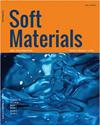Doping of γ -Fe3O4 magnetic nanoparticles in Pluronic F127/ DMF LLCs phases to tune the structural transitions and rheological behavior
IF 1.4
4区 材料科学
Q4 MATERIALS SCIENCE, MULTIDISCIPLINARY
引用次数: 0
Abstract
ABSTRACT A new rapid microwave-assisted approach has been employed to prepare the γ-Fe3O4 magnetic nanoparticles (γ-Fe3O4 MNPs). The formation of spherical γ-Fe3O4 MNPs with an average size of 45 nm and bandgap of 2.3 eV is confirmed by FESEM and UV–Visible spectroscopy. γ-Fe3O4 is doped (0.01 wt% and 0.02 wt%) in the lyotropic liquid crystalline (LLC) lamellar phases of Pluronic F127/N,N dimethylformamide (DMF) to prepare the LLC nanocolloids. Polarizing optical microscopy measurement reveals that γ-Fe3O4 doping does not affect the lamellar LLC structures except 0.02 wt% at 10:90 wt%:wt% system where lamellar to nematic LLC phase transition is observed. Pure LLC phases and nanocolloids are studied for steady and dynamic rheological behavior. LLC phases and LLC nanocolloids possess shear thinning and solid viscoelastic behavior. A complex moduli study of LLCs and LLC nanocolloids is done which indicates the highly elastic strength-based lamellar and nematic phases. Shear-thinning and highly viscoelastic nature of LLCs and LLC nanocolloids have future applications in lubrication, cleaning, cosmetics, and pharmaceutical.在Pluronic F127/DMF LLCs相中掺杂γ-Fe3O4磁性纳米颗粒以调节结构转变和流变行为
摘要采用一种新的快速微波辅助方法制备了γ-Fe3O4磁性纳米颗粒(γ-Fe3O4-MNPs)。FESEM和紫外-可见光谱证实了平均尺寸为45 nm、带隙为2.3 eV的球形γ-Fe3O4 MNPs的形成。在Pluronic F127/N,N二甲基甲酰胺(DMF)的溶致液晶(LLC)片层相中掺杂(0.01wt%和0.02wt%)γ-Fe3O4,制备LLC纳米胶体。极化光学显微镜测量表明,γ-Fe3O4掺杂对层状LLC结构没有影响,但在10:90wt%:wt%的体系中,除了0.02wt%外,观察到层状到向列相的LLC相变。研究了纯LLC相和纳米胶体的稳态和动态流变行为。LLC相和LLC纳米胶体具有剪切变薄和固体粘弹性行为。对LLC和LLC纳米胶体进行了复模量研究,表明基于高弹性强度的层状和向列相。LLC和LLC纳米胶体的剪切变薄和高度粘弹性特性在润滑、清洁、化妆品和制药方面有着未来的应用。
本文章由计算机程序翻译,如有差异,请以英文原文为准。
求助全文
约1分钟内获得全文
求助全文
来源期刊

Soft Materials
工程技术-材料科学:综合
CiteScore
2.90
自引率
0.00%
发文量
21
审稿时长
2.2 months
期刊介绍:
Providing a common forum for all soft matter scientists, Soft Materials covers theory, simulation, and experimental research in this rapidly expanding and interdisciplinary field. As soft materials are often at the heart of modern technologies, soft matter science has implications and applications in many areas ranging from biology to engineering.
Unlike many journals which focus primarily on individual classes of materials or particular applications, Soft Materials draw on all physical, chemical, materials science, and biological aspects of soft matter. Featured topics include polymers, biomacromolecules, colloids, membranes, Langmuir-Blodgett films, liquid crystals, granular matter, soft interfaces, complex fluids, surfactants, gels, nanomaterials, self-organization, supramolecular science, molecular recognition, soft glasses, amphiphiles, foams, and active matter.
Truly international in scope, Soft Materials contains original research, invited reviews, in-depth technical tutorials, and book reviews.
 求助内容:
求助内容: 应助结果提醒方式:
应助结果提醒方式:


